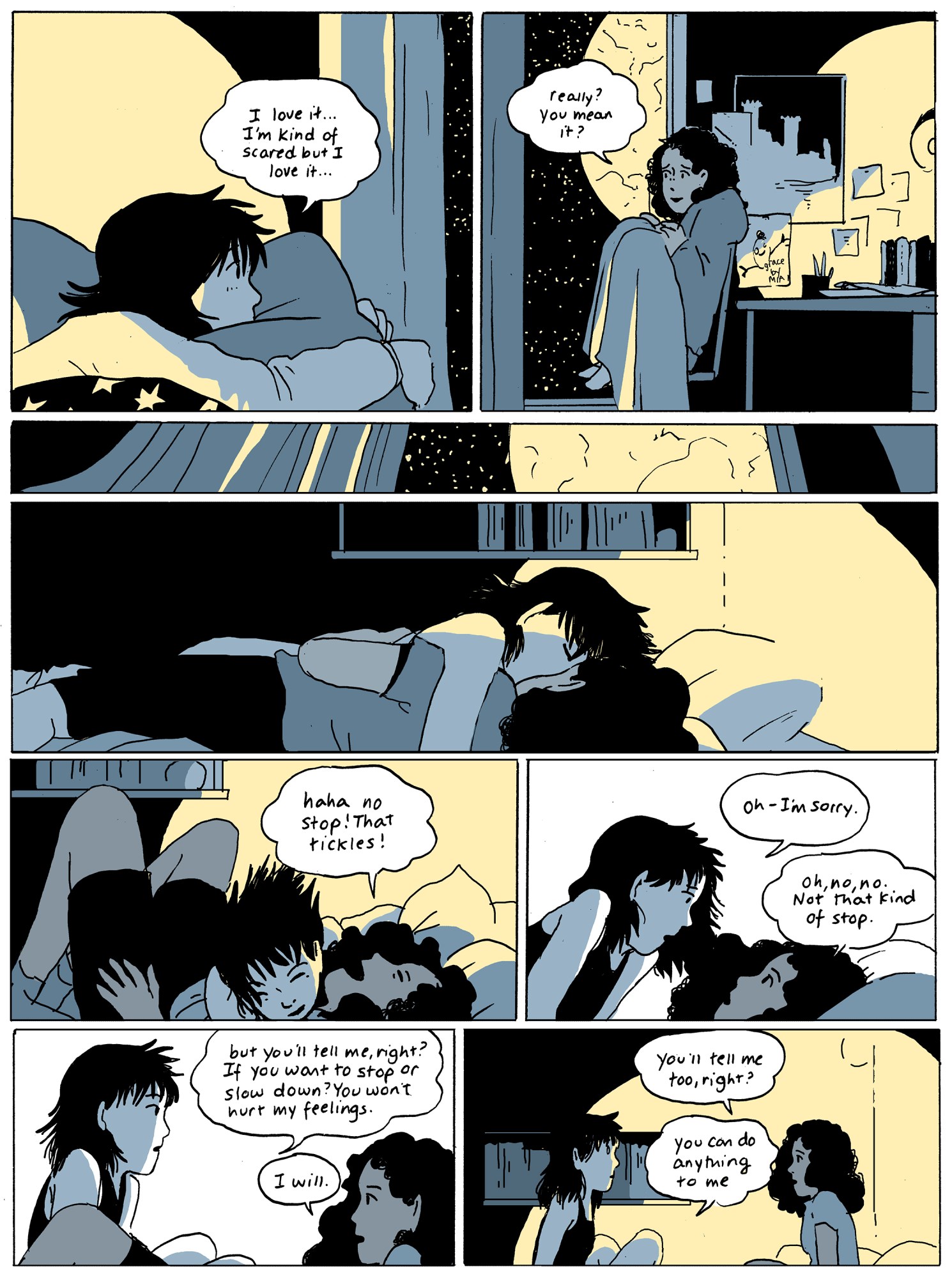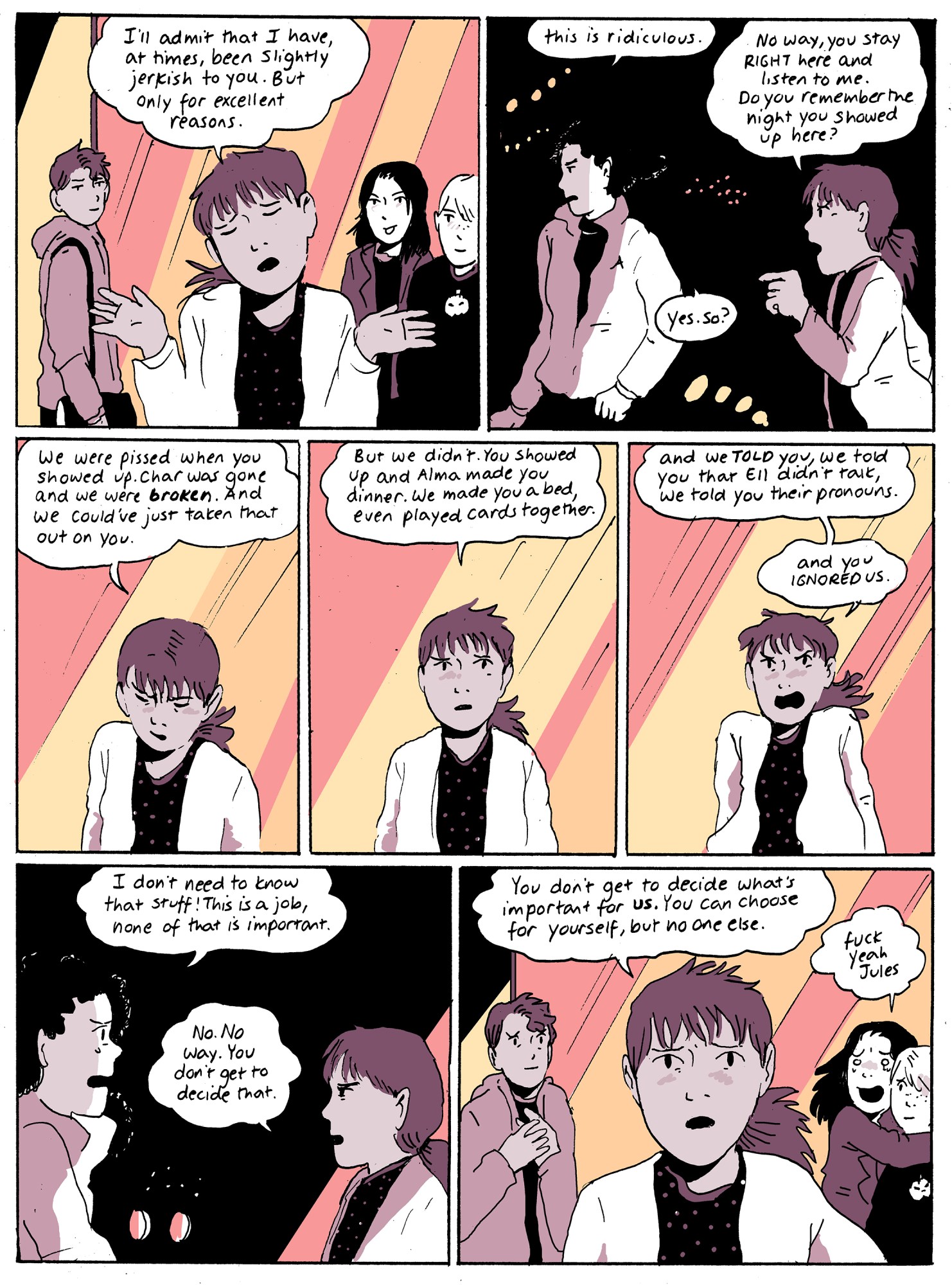Tillie Walden is sick of fantasies dreamed up by men. “It feels like any subject matter outside of the real world, whenever we’re talking about our fantasies,” says the 22-year-old comic illustrator, “they’re always designed by men.” In On a Sunbeam, her fifth graphic novel, she attempts to mend this imbalance. “I wanted to create a fantastic world, an entire vision based around who I am, what it means to be a woman, what it means to be gay.”
Set in an interstellar universe of crumbling towers and fish-shaped spaceships, On a Sunbeam is a 533-page tale that begins with Mia joining a traveling construction team that fixes broken buildings. It then takes us back in time to five years earlier, with Mia refusing to get out of her bed at a glum, blue-hued boarding school in outer space. This is where she meets Grace and the pair fall deeply in love. In the two interwoven narratives that ensue, Walden develops the plot: their strange split, and a dangerous journey towards reunification. It’s a structure sci-fi fans will recognize, but with a mostly female cast (there’s also a nonbinary character called Elliot and a cat that’s male).

When Walden was growing up in Austin (which is “still unfortunately Texas”), she found very few queer relationships in the popular culture she consumed. “I was frustrated with my identity as a lesbian being boiled down to the witty side character, and wanted stories that were about me, and I didn’t want to be a concept or a line.” Now, she feels a responsibility to her audience of mostly teenagers and queer people, to create work that informs and inspires. She’s synthesized what bugs her about the micro-aggressions and the subtle ways people disrespect her on a day to day basis, and uses On a Sunbeam to discuss real issues surrounding gender, sexuality, romance, and consent.
In one scene, for example, a crew member called Jules stands up to the ship’s commander who continually ignores Elliot’s chosen them/their pronouns. “Have you ever even considered that something that’s trivial to you could mean…So much more to someone else?” she asks. “You don’t get to take the easy road out and just respect the parts of people that you recognize.” In an increasingly hostile America where gender identity is being targeted — just recently The New York Times reported that the Trump administration would consider defining gender as a biological condition determined by genitalia at birth — it is refreshing to find a plea for compassion subtly woven into a book of fantasy and adventure. The same can be said for her repetition of consent after a year of #MeToo and shared stories about sexual misconduct. “Consent,” Walden says, “is often presented as being a turn off, whereas I think actually it can be a total turn on. It can be very empowering and cool.”

Walden’s work comes at a time where young people are demanding a more progressive world, and the author is no exception. Impeccably articulate, vivacious, and mature beyond her years, she has cropped hair, a quick tongue, and a work ethic she claims comes from her years as a competitive figure skater. Before graduating from high school Walden had already published her first graphic novel, The End of Summer, about a family in a palace frozen in winter, quickly followed by I Love This Part, which she won an Ignatz Award award for in 2016. Her poetic A City Inside came next, then Spinning, a memoir about figure skating, coming-of-age, and coming out in Texas at the age of 14. After Spinning, she was exhausted by real life and wanted to do something as far away from the ice rink as possible. “Obviously the first thing I thought of was outer space,” she says with a laugh.
Walden is already a prolific comic illustrator, but she had a late start. In fact, she admits to having absolutely no aspiration to be a graphic novelist until she was 17 and her Dad signed her up for a workshop with cartoon critic Scott McCloud. She’d read graphic novels growing up, taking a liking to the black and white line drawings of Japanese manga, but found North American comics overly colored to the point where she couldn’t really appreciate the artist’s lines. Now, Walden finds influence in the multifaceted work of Jillian Tamaki, who focuses on women grappling with societal expectations, both in real life and online. Like Tamaki, Walden continues to change and adapt in her comics, finding freedom within the medium to experiment with different styles.
On a Sunbeam was heavily inspired by the manga Walden enjoys, in that all 500 pages were sketched by hand, using ink on paper. The style is simple: eyes are dots, mouths are singular lines, yet the crumbling buildings are complex, and “The Staircase,” an almost entirely uninhabited land at the “farthest edges of space” was created with intricate swirls of her pen. Her characters have distinctive facial features, hairstyles, outfits, and skin colors, which is helpful with such a large cast, and convey their wide-ranging personalities. The color palette is minimalistic with just two main colors used throughout the book: a dull blue for memories and school, and shades of pink to symbolize new beginnings, which were added digitally on Photoshop in the novel’s final stages.
On a Sunbeam was first published in its entirety as a 20-part weekly webcomic, and still exists online for free. “I wanted people who don’t have the money for a book to be able to read them,” she explains. “I think it makes the world a better place.” Because of this, On a Sunbeam was imagined, written, designed, and produced at “an absolutely insane rate,” in the Los Angeles home Walden has escaped to from Texas, where she never felt welcome. “The book is about people who are finding their way in the world. I was making it at a time where I was trying to figure out what my place was and luckily I found my place and I feel like my characters did too.”
